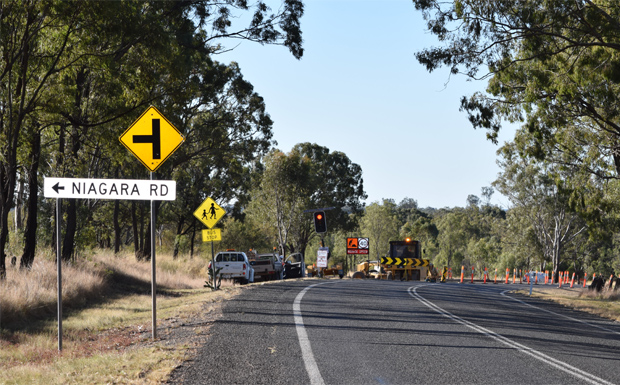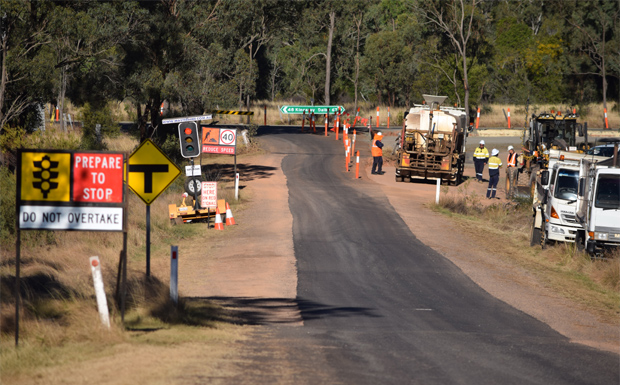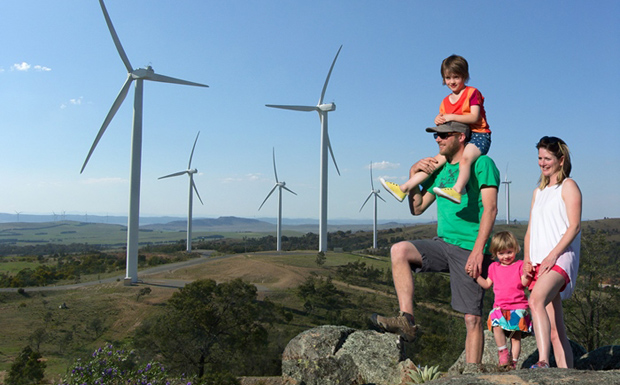
June 4, 2018
The southern section of Niagara Road in Boyneside is being upgraded to allow components for the Coopers Gap Wind Farm to be shifted on to the site.
A quarterly Community Consultative Committee (CCC) meeting held at Cooranga North Hall last Thursday was told components for the wind farm have been arriving at Brisbane’s port since February.
They will start being shifted from storage sheds in Brisbane to the Coopers Gap site in late June or early July once a route has been agreed with the Department of Transport and Main Roads.
In order to move turbine components to the areas of the wind farm closest to the South Burnett, Niagara Road’s intersection with the Bunya Highway at Boyneside is currently being widened.
The wind turbine blades are 52m (about 171 feet) in length and the current turning area in not wide enough without an intersection upgrade.
The company is also negotiating with the South Burnett Regional Council to upgrade Niagara Road.
Cr Ros Heit told the meeting the road has more than 20 culverts that will require reinforcing to handle the enormous weight of components that will be transported along it, including two 260-tonne transformers required by the new electricity substation being built in the area.
She understood the current plan was to widen Niagara Road from 5m to 7.5m, although this would not be possible on all sections.
Some rises along the road would also be levelled off, and existing bitumen sealing would be removed to convert the road to a uniform gravel surface.
The bitumen would be restored after all components had been delivered to the site and construction of the wind farm was completed.
This was was likely to take until at least mid-2019.

* * *
Work on supplying houses located within 2km of the wind farm site with free solar power systems is almost complete.
Last year, AGL offered to supply free solar systems to properties adjoining the wind farm’s borders – but not hosting turbines themselves – to compensate them for any loss of visual amenity the wind farm might cause.
Installation of the solar systems began as soon as the project received a go-ahead, and Thursday’s meeting was told work was now almost complete, with only “three or four” remaining to be installed.
The aim of the solar systems was to take local residents off the grid, saving them several thousand dollars a year in power bills.
* * *
Jandowae and Bell secured the bulk of successful grant applications in the second round of AGL’s Community Benefit Fund grants scheme.
However, the Kumbia School Of The Arts secured a grant to upgrade the hall’s kitchen, and the South Burnett Senior Citizens Centre in Kingaroy secured another to hold a Seniors Week event.
The meeting was told the grant’s focus area in the second round was Western Downs towns, but the intention of the fund was that its benefits would be split fairly across the Western Downs and South Burnett regions over time.
* * *

Viewing areas for tourists wanting to look at the wind farm and signage to direct them to viewing platforms will be examined by AGL following a suggestion from the CCC.
Committee member Mick Cosgrove told the meeting he was certain the wind farm would draw a steady stream of visitors eager to see what Australia’s biggest wind farm looked like once Coopers Gap was built.
However, roads in the area around the wind farm were narrow and he thought this could be unsafe.
Mr Cosgrove suggested AGL look at developing some off-road viewing areas where tourists could photograph the Wind Farm in safety.
AGL Coopers Gap construction manager Tim Knill told the meeting the company would look into Mr Cosgrove’s suggestion.
Mr Knill said he also thought it might be productive if a two-council tourism sub-committee comprising representatives from the South Burnett and Western Downs Regional Councils was formed to provide input into the project.
Cr Ros Heit said she would be happy to sit on such a sub-committee.
* * *
The arrival of the NBN around the Coopers Gap area will herald the end of landlines for residents unless they take action to retain them, the meeting was told.
During discussions about the poor state of mobile communication in the area and AGL’s efforts to put a better system in place, AGL’s senior manager for Government and Community Relations Clare Mildren warned residents they would lose their landlines 12 to 18 months after the NBN arrived unless they lodged a written request to retain them.
Ms Mildren said under the Federal Government’s Universal Service Guarantee, all Australian homes and businesses – regardless of their location – were entitled to be provided with access to both voice and broadband services.
The USG also ensures that areas with specific needs have access to payphones or equivalent community voice services, especially communities with no mobile phone coverage.
Ms Mildren said until mobile problems in the Coopers Gap area were resolved, any resident who was advised their landline service would be phased out should apply to their supplier to keep their landline operating until mobile problems were fixed.
Ms Mildren said the NBN was not a substitute for voice communications, and lodging a written objection would be sufficient to preserve a resident’s landline service until the Coopers Gap “mobile black spot” problem was remedied.
* * *
Wind Farm Construction Manager Andrew Baker told the meeting that work on building bases for the wind farm’s turbines has begun in earnest over the past three months, with an average of “between three and four” being built each week.
The turbine bases are concrete pads used to anchor the 135m (about 443 feet) wind turbines in place.
At present, work on the turbines is only 10-14 days behind the original schedule – largely due to geotechnical issues about finding the best sites to build them – and he was hopeful work would be fully back to schedule in the near future.
Mr Baker said each base used 154 bolts to anchor each turbine in place, along with “packers” to ensure each turbine was within 0.5mm of being perfectly straight.
This was checked by a surveyor as each turbine’s lower section was anchored into place.
* * *
After the Coopers Gap Wind Farm is built, the project will create 20 to 25 full-time maintenance jobs that will last the project’s estimated 25-year life span.
Preference for these jobs will go to residents living within easy driving distance of the wind farm, since staff may be required to attend out-of-normal work hours in certain situations.
The need for maintenance staff was expected to begin ramping up towards the end of 2018, and positions would start being advertised when this occurs.
Principal contractor GE-Catcon will be hiring the permanent maintenance staff, since they will be operating the wind farm once it’s built.
People interested in one of these positions should lodge their resume with GE-Catcon through their website
Related articles:























